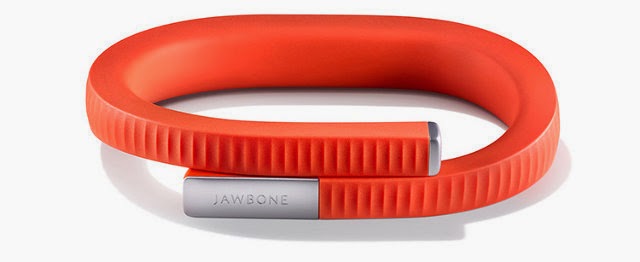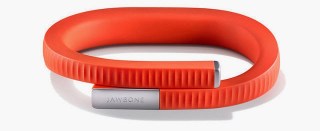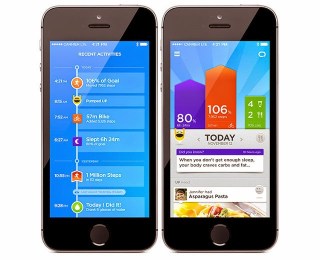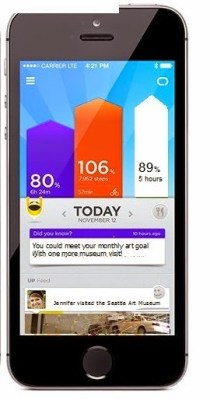
I’m excavating the stratigraphic accumulation of emails, reports, requests and assignments while I was at the Alliance annual meeting last week. Mindful of those who could not join us in Seattle, I’ll share highlights and links via Twitter and this blog in the coming month(s), subject to the speed with which I can process all the great stuff I heard. Here is a first installment, based on thoughts I shared (which are easier to access, in my post-meeting daze).
One way I use the annual meeting is as an amplifier and filter: if I incorporate a dozen fringy ideas into my conversations and presentations, which ones resonate most strongly with listeners? Which provoke laughter (genuine or nervous), eye-rolls or follow-up questions?
This year my vision for biometric monitoring of cultural engagement generated the most chuckles, eye-rolls and thoughtful nods, so I’m sharing that with you, first.
This is a Jawbone Up.
I’ve been wearing one for five months now. It tracks my activity (with “steps” being a metaphorical, rather than literal, measure of movement—it isn’t actually a pedometer) and my sleep (again, an approximation based on on movement—I’m not wearing an EEG monitor to bed). I could also enter information on my mood and everything I eat, but I don’t. The purpose of biometric monitoring, after all, is to support self-determined goals, and I’m not trying to change my mood or my calorie intake.
Here is a screen shot of (someone else’s) Jawbone app screen. You can see “Jennifer’s” daily summary for activity, sleep and food (as well as her mood, a full-on, arms-up “Fiero” emoticon.) On the left you see a timeline of recent activities, including progress to self-set goals like drinking 8 glasses of water.
So my crazy idea: why not another bar on the screen—one for Cultural Engagement?
I can think of a number of ways a biometric band could track cultural engagement, for example:
- The monitor itself, or your mobile device, could check your GPS location against cultural organizations (such as the 35,144 museums in IMLS’s newly released database)
- With your permission, a museum could send a “cultural engagement” ping directly to the monitor’s app, which might also interface with the museum’s own indoor wayfinding (did you spend more time in the hall of mammals, or the dino lab?)
- A user could “check in” via the app, adding a culture hit the same way users can currently manually add sleep or exercise. (“Cultural Engagement type: art museum; engagement level: light; start time: 2 pm; duration: 1 hour 20 min.” And then I could add a smiley emoticon to indicate the visit made me happy J.)’
¬(Cultural Engagement Bar, to right)
¬(Jennifer is happy to have visited SAM)
I’ve written about how collecting “big data” on cultural engagement could prove to be the holy grail of museum metrics. But first we have to collect the data we are going to add to the big data pool—enlisting people who have voluntarily joined the “quantified self” movement to collect and share information on how they use our resources, what goals they set for that engagement and how it makes them feel, is one place to start.
So, all of you readers wearing biometric monitors—Up, Flex or Force, Shine, Fuelband, Pulse or others—would you use your device to monitor how you interact with arts & culture (including natural history and science) if you had the choice?
And, Jawbone, Fitbit, Misfit, Nike, Withings, are you listening?












Not a chuckle, eye-roll or nod but a "hmmm…" here. What do you think would be a visitor's motivation to quantify themselves in this way? Is it wellness, as many such devices seem to focus on?
Interestingly, cultural vitality (like visiting a museum) is considered one of the domains of Gross National Happiness (see happycounts.org), but I wonder if that's enough reason for people to pursue it in a general sense.
I wear a Fitbit, but I wear it for one specific purpose (to track my steps per day). I don't use it to track my sleep or water or calories, though it could do all these things. And that's what you said in your presentation, too: that you don't use all the functions your Jawbone Up could be doing.
I wonder (like Andrea above) if tacking on cultural engagement to these biometric devices might not be a function that museum pros might like but not one that users would choose to engage with.
I'm not sure it works to add functionality to devices that people are already choosing for one or two specific purposes.